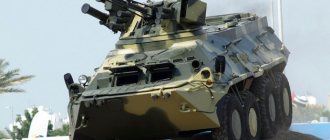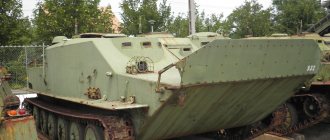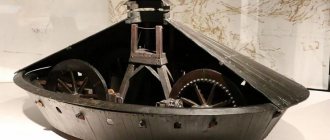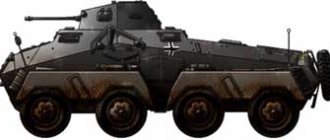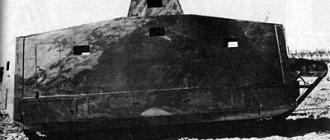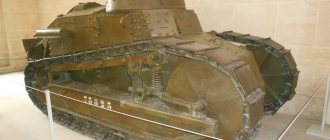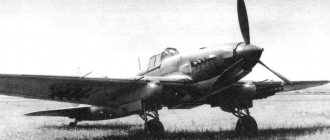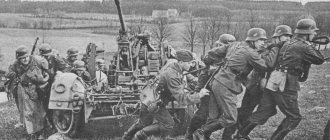From the beginning of the Second World War until its end, the Sd.Kfz.251 half-track armored personnel carrier was a constant companion of the German troops. This image is formed by movies, where German soldiers are necessarily armed with MP-38/40 submachine guns and move in armored vehicles (in Soviet cinema, their role is played by the BTR-152, which has a characteristically chopped hull shape).
The Sd.Kfz.251 armored personnel carrier is often called the “Hanomag”, although this designation is erroneous. The car was developed by another and was only one of the armored car manufacturers. The company is known for a range of automobiles and tractors. One of the most popular models was the minicar Hanomag2/10 PS Kommisbrot, built in significant numbers in the 20s. No less famous is the Hanomag WDZ 50 tractor, which served as the prototype for the Soviet Kommunar tracked vehicle.
History of creation
The development of armored vehicles intended for transport and fire support of infantry began in Germany in the mid-30s. The prototype of the future Sd.Kfz.251 machine under the designation Hl6 was created by Hansa-Lloyd, which was part of the Carl FWBorgward concern. A little later, the license for the right to produce the chassis and armored hull was purchased from Hannover.
In 1938, Borgward, and then Hanomag, produced the first chassis for the new armored personnel carrier. The basis was the platform of the half-track artillery tractor Sd.Kfz.11, which by that time was being built in series. The prototypes were tested under the designation HKL6p. By the end of the year, armored personnel carriers of the so-called 0-series appeared. The vehicle received the classification of a medium armored personnel carrier - mitteler gepanzert Mannschaftstransportwagen (MTW). According to the classification of the Armament Directorate, the vehicle was assigned the index Sd.Kfz.251.
The assembly of serial Sd.Kfz.251 vehicles began in the summer of 1939 at the Deutsche Werke (Kiel) and Borgward (Bremen) factories.
At the same time, welded hulls made of armor or ordinary structural steel were produced in parallel. Both types of vehicles entered service with Wehrmacht infantry units and took part in battles in Poland. As output increased, other firms began to be involved in production. So, at the beginning of 1941, the Czech plant in Böhmisch Leipa, which assembled riveted armored hulls, joined the production of vehicles.
Subsequently, the assembly of armored vehicles was carried out by at least 10 enterprises located on the territory of the Third Reich. Among them are Gollnow, Weserhuette, Wumag, Hanomag, MNH, and Schichau. Due to the large number of manufacturers, Sd.Kfz.251 armored personnel carriers of the same production period differ in various elements, such as roller tires, structural elements of the front wheels, tracks, etc.
Combat use
Hanomag armored personnel carriers at the parade
The use of Hanomag armored personnel carriers is associated with the Second World War. These vehicles entered service before its start and finished production in March 1945, towards its end.
The basic use of armored personnel carriers is the mobile movement of soldiers. The vehicle proved itself on rough terrain in North Africa and Eastern Europe due to its cross-country ability. If necessary, the armored personnel carrier provided transportation of light guns and supply of ammunition.
The Hanomag was also used in combat operations as a mobile firing point. Thanks to its armor, the vehicle provided infantry cover. Depending on the weapons, it could fire at enemy infantry, tanks and light armored vehicles, as well as at air targets.
Modifications
To designate modifications of German armored vehicles, the term Ausführung is used - model, followed by the letter designation of the version. The first version of the Ausf.A armored personnel carrier is easily distinguished by additional viewing devices located on the upper part of the fighting compartment hull. The Notek antenna and headlight were located on the wing of the car.
On the subsequent model Ausf.B, the number of viewing devices was reduced; only the driver and radio operator had them. The antenna was moved to the top sheet, in the area of the radio operator's workplace. The Notek headlight received a bracket mounted on the upper side sheet of the engine compartment of the car.
Production of the new version C, differing in the design of the frontal part of the hull, began in 1940. Moreover, at this moment several new enterprises joined the production (at least Schichau and MNH).
https://www.youtube.com/watch?v=8xG1cVB6OY4
But in parallel there was a production of cars and previous versions, which ended only in the middle of next year. For armored personnel carriers of version C, a characteristic external feature is a blank flat frontal sheet of the engine compartment and armored casings for hot air exhaust channels located on the sides of the hood. The latest modification, Ausf.D, began production in the fall of 1943.
The machine is distinguished by an extended hull (welded construction only) with a flat inclined stern sheet. The new Sd.Kfz.251 hull consisted of fewer parts and was easier to manufacture, which made it possible to increase production. In total, more than 10.6 thousand Ausf.D units were assembled; for comparison, the total volume of previous modifications of the armored personnel carrier was 4.65 thousand vehicles.
Based on basic modifications, 23 versions of the Sd.Kfz.251 were produced. Moreover, some versions could use several chassis, and some were mounted on the basis of only a late modification of the Ausf.D armored personnel carrier.
Serial options:
- 251/1, the standard version for transporting 10 infantrymen, is armed with one or two MG34 or 42 machine guns equipped with an armored shield;
- 251/2, a version designed to mount an 8 cm mortar and carry 66 rounds of ammunition;
- 251/3, an armored personnel carrier equipped with additional radio stations (communication vehicle);
- 251/4, a variant used to transport field howitzers, crews and a small supply of shells;
- 251/5, an early sapper version of the vehicle;
- 251/6, an armored personnel carrier adapted for use as a command post for large army units;
- 251/7, late sapper version, supplemented by assault bridges on the sides of the hull;
- 251/8, an ambulance, was distinguished by its coloring with a red cross;
- 251/9, assault version with a short-barreled 75 mm KwK 37 or K51 gun (analogous to that used on early PanzerIV);
- 251/10, version with reinforced weapons (37 mm Pak 36 anti-tank gun with a standard shield shortened in height or PzB 39 anti-tank gun);
- 251/11, telephone cable layer;
- 251/12, command vehicle version for artillery units;
- 253/13 and 251/14, rare variants designed for sound reconnaissance;
- 251/15, reconnaissance photometric vehicle version;
- 251/16, the armored personnel carrier is additionally equipped with two flamethrowers, a mixture tank and a motor pump;
- 251/17, mounted 20 mm Flak 38 anti-aircraft complex, differs in the design of the hull sides;
- 251/18, communications and observation armored vehicle;
- 251/19, mobile telephone point;
- 251/20, an armored personnel carrier with the installation of an infrared searchlight to illuminate targets;
- 251/21, an anti-aircraft version of the vehicle with the installation of three MG151 guns (with barrels of 15 or 20 mm caliber);
- 251/22, self-propelled gun with Pak40 anti-tank gun;
- 251/23, option with the installation of a Hangelaffete 38 rotating turret with a pair of MG151 cannon and MG42 machine gun.
In addition to the Sd.Kfz.251 armored personnel carriers listed above, there were front-line handicraft designs made in single copies.
Medium armored personnel carrier Sd.Kfz.251
Medium armored personnel carrier Sd.Kfz.251
Sd.Kfz.251 was a medium half-track armored personnel carrier designed to transport a motorized infantry squad. The basic vehicle, a half-track tractor, was developed by Hansa-Lloyd-Goliath Werke AG in Bremen in 1933 and bore the corporate designation HLkl 6. All documentation for the design of the chassis for the HLkl 6p armored personnel carrier in 1935 was purchased by Hanomag, which then worked on it production. Apparently, for this reason, in all Soviet documents during the Great Patriotic War, it appears under the name “Hanomag”, which was never used in the Wehrmacht. The armored hulls came from Bussing-NAG, and assembly was carried out at the factories of Hanomag, Borgward, Hansa-Lloyd-Goliath, Weserhutte, Wumag, Schichau, MNH, Stoewer, Deutsche Werke and Evans+Pistor.
The armored personnel carrier had an open top armored body, welded from rolled armor plates located at large angles of inclination and bolted to the chassis frame. The thickness of the armor ranged from 8 mm at the sides and stern to 10-15 mm at the front hull plates. Boxes with spare parts and equipment were attached to the fenders. The chassis had a classic automotive layout with the engine located in front of the driver's cabin, as a result of which the control compartment was located in the middle of the vehicle, between the engine and troop compartments. A double door at the rear of the hull was used for landing and disembarking troops. There were no loopholes in the sides, and infantrymen could fire from personal weapons only over the sides. The standard armament of the armored personnel carrier consisted of a 7.92 mm MG 34 machine gun mounted on the roof of the control compartment and covered with an armor shield. If necessary, the machine gun could be moved to a swivel mounted on the rear plate. This swivel could also fire at air targets.
Armored personnel carrier Sd.Kfz.251 Ausf.A. 1st Panzer Division, Eastern Front, 1941. On early production vehicles, the machine gun did not have a shield cover
Armored personnel carrier Sd.Kfz.251 Ausf.B. Greece, 1941
The armored personnel carrier was equipped with a six-cylinder carburetor in-line liquid-cooled Maybach HL 42TUKRM engine with a displacement of 4171 cm? and power 100 hp. at 2800 rpm, allowing the 8-ton car to accelerate on the highway to a maximum speed of 53 km/h.
The engine was started by an electric starter and was duplicated by an inertia starter with manual spin-up, which was recommended for use in the cold season. However, tests of a similarly equipped German F3 artillery tractor carried out in January 1940 at the Leningrad artillery range showed that an inertial starter is an effective starting tool only at a temperature not lower than -5°. At lower temperatures, preheating of the engine was required. However, perhaps, in the conditions of a milder Central European winter, this circumstance was not decisive.
A fuel tank with a capacity of 160 liters was located under the floor of the troop compartment in the rear of the hull. The maximum range of the car when driving on the highway reached 300 km.
The main clutch of an armored personnel carrier is a dry, double-disc clutch with a central spring. The gearbox, range and double differential were mounted in one housing. The gearbox is a three-way, four-speed, with constant mesh gears. The multiplier had two gears—direct and reduction.
Characteristic differences in the design of armored personnel carriers
Ausf.C
Armored transporter Sd.Kfz.251 Ausf.B
The vehicle was controlled using an automobile-type steering mechanism. Turning at a small angle (up to 6°) was done by turning the front wheels; during sharper turns, in addition, the corresponding track was braked. For this purpose, the steering of the front wheels was synchronized with the control of the double differential brakes. The force on the brakes was transmitted using a hydraulic drive. A double differential (cylindrical with a pair of bevel gears) was intended to transmit torque to the drive wheels of the tracked drive. To completely stop the armored personnel carrier, in addition to the hydraulic drive, there was a pneumatic one, which also acted on the double differential brakes. The design of the brakes was similar to that of a car. Since all armored personnel carriers were equipped with a towing device, the pneumatic braking system was designed to simultaneously brake the trailer.
Sd.Kfz.251/1 Ausf.C
Front view
Back view
The armored personnel carrier's suspension was mixed. The wheeled front axle, equipped with pneumatic tires size 190-18, was suspended on a transverse semi-elliptical leaf spring. The tracked mover had an independent torsion bar suspension. The propulsion unit of each side consisted of six double rubber-coated road wheels, arranged in a checkerboard pattern with mutual overlapping of the roller disks, a front drive wheel and a guide wheel with a tension mechanism.
The ridge-geared steel tracks had a width of 280 mm and consisted of 55-56 tracks each. The track fingers were mounted on needle bearings and provided them with greater wear resistance, as well as high chassis efficiency and good vehicle dynamics. According to tests of German half-track vehicles in 1940 at the NIBT Test Site and the Leningrad Artillery Test Site, such a track could operate reliably within a range of 12-15 thousand km.
Interior of the control compartment of the Sd.Kfz.251 armored personnel carrier. Noteworthy is the reverse tilt of the steering wheel, characteristic of all German armored personnel carriers and armored cars.
Armored personnel carriers Sd.Kfz.251 Ausf.C of the 24th Tank Division at the crossing. Eastern Front, 1941
To ensure quiet operation of the armored personnel carrier, protection of paved roads from destruction and reliable operation of needle bearings, a rubber cushion was bolted to the outer part of the track using bolts. The caterpillar track had a different cross-section in height, due to which as the track was immersed in the ground, the specific pressure decreased. This design feature of the track ensured increased maneuverability on soft soils. However, the front wheels, which had a high specific pressure, sank into the ground when driving on muddy roads, which created excessive additional resistance to movement. At the same time, either the caterpillar mover slipped or the engine stalled.
Installation of an MG 34 machine gun behind a shield on an Sd.Kfz.251 Ausf.B armored personnel carrier. Eastern Front, 1943
Characteristic differences in the design of armored personnel carriers
Ausf.C
Ausf.D
Unlike the tank, the Sd.Kfz.251 armored personnel carrier was not a full-fledged all-terrain vehicle. The chassis provided it with high mobility on paved roads, and on dirt roads and terrain only in dry summer times, which significantly limited the tactical use of the armored personnel carrier.
However, from June 1939 to March 1945, German factories produced 15,252 combat vehicles of 23 modifications in four basic versions. Until September 1943, variants A, B and C were produced (4,650 units), and then until the end of the war - D (10,602 units). The basic versions had no fundamental design differences, but differed from each other in the form and method of fastening some components and parts of the armored hull. For example, option B differed from option A mainly in the absence of viewing slots in the sides of the fighting compartment and the transfer of the antenna from the wing to the side of the hull. Option C had more differences. The entire front part of the hull underwent changes: the frontal sheet of the engine compartment became straight, the air intake louvers were moved to the sides and covered with armored casings, the boxes for spare parts and equipment were moved closer to the stern. The most noticeable differences of option D were the new inclined stern plate of the hull, the integration of spare parts boxes into the sides of the hull and the newly modified design of the engine compartment armor. As for the modifications, each of them could include armored personnel carriers of any of the variants, and sometimes all four.
The main production model of the armored personnel carrier was designated Sd.Kfz.251 /1 and was intended to transport an infantry squad (10 people). In addition, this version was used to transport the MG 34 machine gun on a tripod. In this case, the front standard machine gun of the armored personnel carrier was dismantled, and a heavy machine gun was placed in the fighting compartment.
Sd.Kfz.251/1 Ausf.D
Front view
Back view
Finally, there was a third version - mittlerer Schutzenpanzerwagen mit Wurfrahmen, on which launch containers for launching rockets - Wurframen 40 - of 280 and 320 mm caliber were placed on the sides outside the hull. Three containers were attached to each side. Horizontal guidance was carried out by turning the armored personnel carrier, vertically using a special lifting mechanism in the range from +5° to +40°. The salvo was fired for 10 seconds. The combat weight of this version when equipped was 9.14 tons. The crew was 7 people.
The second modification was the self-propelled mortar—mittlerer Schutzenpanzerwagen mit Granatwerfer Sd.Kfz.251/2. The armament consisted of an 80-mm sGrWr 34 mortar placed inside the body (66 rounds of ammunition) and one MG 34 auxiliary machine gun (2010 rounds of ammunition). The combat weight of the vehicle is 8.64 tons, the crew is 8 people. Self-propelled mortars Sd.Kfz.251/2 were in service with support platoons (heavy weapons) of motorized infantry companies.
The Sd.Kfz.251/3 variant was a communications vehicle (mittlerer Funkpanzerwagen). Depending on the purpose (4 options), they were equipped with radio stations Fu 4, Fu 5, Fu 7, Fu 8, Fu 11 and Fu 12 in various combinations. Mast, whip and loop antennas were used. There were the following main options: Sd.Kfz.251/3 II - communications vehicle in tank formations; Sd.Kfz.251/3 III - vehicle for communication with aviation; Sd.Kfz.251/3 IV—control vehicle with radio stations Fu 11 and Fu 12; Sd.Kfz.251/3 V—control vehicle with Fu 12 radio station.
Armored personnel carrier Sd.Kfz.251 Ausf.C, equipped with metal containers for launching 280-mm high-explosive fragmentation rockets
Options for launch containers and their mounting on the body of an armored personnel carrier
wood
metal
Armored personnel carrier Sd.Kfz.251 Ausf.C, equipped with wooden containers for launching 320-mm incendiary rockets. 24th Panzer Division, Eastern Front, 1941
Sd.Kfz.251/2 Ausf.C
Sd.Kfz.251/3 Ausf.A
Command staff communications vehicle Sd.Kfz.251/3 IV, equipped with Fu 11 and Fu 12 radio stations, which had a telescopic mast and loop antenna, respectively
Modification Sd.Kfe.251/4 (mittlerer Schufeenpanzerwagen fur Munition und Zubehor des le IG 18) was used as an artillery tractor for towing light infantry guns le IG 18 75 mm caliber, 105 mm light field howitzers le FH 18/1 and anti-tank guns of 37-75 mm caliber. The combat weight was 8.75 tons, the crew was 7 people, the armament was one MG 34 machine gun. The armored personnel carrier could carry up to 120 rounds of 75 mm caliber.
The Sd.Kfe.251/5 variant was a vehicle for transporting sappers and sapper equipment - mittlerer Schufeenpanzerwagen fur Pionier. The combat weight of this modification for the engineering troops was 8.87 tons, the crew was 9 people, the armament was one MG 34 machine gun (ammunition 4800 rounds). Some of the vehicles had Fu 8 and Fu 4 radio stations.
The Sd.Kfz.251/6—mittlerer Kommandopanzerwagen armored personnel carrier was used as a mobile command post for senior commanders (division, corps, army). The weight of the vehicle was 8.5 tons, the crew included 8 people. Radio stations Fu 11 and Fu Tg were installed, and from 1943 - Fu 19 and Fu 12. Frame-type antennas were used. Armored personnel carriers of this modification were also equipped with Enigma encryption machines. Sd.Kfz.251 Ausf.A armored personnel carriers were most often converted into mobile command posts.
Interior of a Luftwaffe communications vehicle with a Fu 7 radio station. A non-standard MG 15 aircraft machine gun is installed on the stern swivel
Armored personnel carriers for engineering troops Sd.Kfz.251/5 are easily recognized by the electrical cable bays attached in front of the hoods
Armored personnel carrier Sd.Kfz.25V4—an artillery tractor for transporting ammunition and towing a 105-mm field howitzer Le FH 18
The version for the engineering troops, Sd.Kfz.251/7—mittlerer Pionierpanzerwagen—was an improved Sd.Kfz.251/5. Assault bridges were placed on special brackets along the sides of the hull. Some of the vehicles were equipped with a Fu 5 radio station.
The armored ambulance Sd.Kfz.251/8 (mittlerer Krankenpanzerwagen) could accommodate two lying and four seated or eight seated wounded. The top of the body of the ambulance armored personnel carrier was covered with a tarpaulin. A water tank was attached to the stern or side plate of the hull. This modification had no weapons.
The armored personnel carrier modification Sd.Kfz.251/9 (mittlerer Schutzenpanzerwagen fur 7.5 cm KwK 37) was a self-propelled unit with a 75-mm KwK 37 (later K 51) short-barreled gun. The gun's horizontal pointing angles are ±12°. To aim at the target, the Sfl ZF1 telescopic sight was used. Ammunition: 52 rounds. Combat weight—8.53 tons, crew—5 people, additional weapons—one MG 34 or MG 42 machine gun. On early production vehicles, the 75-mm cannon was recessed into the front plate of the fighting compartment, on later ones it was located on the roof of the control compartment and protected front and sides with a light armored superstructure.
Mobile command posts Sd.Kfz. 251/6 was also readily used by senior military leaders, including the most famous German tank commander, General G. Guderian
and the commander of Army Group Center, Field Marshal Von Bock. The first photograph was taken in France in 1940, the second on the Eastern Front in the summer of 1941
The armored personnel carrier for engineering troops Sd.Kfz.251/7 carried two assault bridges on special brackets on the sides of the hull
Another cannon version, the mittlerer Schutzenpanzerwagen 3.7 cm Pak Sd.Kfz.251/10, was used as a platoon commander's vehicle in motorized infantry units. Armament: 37-mm Rak 35/36 anti-tank gun (168 rounds of ammunition) behind a standard shield and an MG 34 machine gun (1,100 rounds of ammunition) or a PzB 39 anti-tank gun of 7.92 mm caliber (40 rounds of ammunition). On later production vehicles, the 37 mm guns did not have a shield.
The combat weight of the vehicle was 8.02 tons, the crew consisted of 5 people.
Since August 1942, the signal troops received a machine for laying telephone cable Sd.Kfz.251/11 - mittierer Femsprechpanzerwagen. Two trailers could be used with this armored personnel carrier, on which cable reels were placed: Feldkabeltrager (gp) and Feldkabeltrager 10(gp). The Fla vehicle was equipped with a special mast for cable laying and a cable feeder mounted on the right wing of the armored personnel carrier. In addition, these machines were often equipped with an Enigma encryption machine. The crew included 5 people and was armed with an MG 34 machine gun.
Sanitary armored personnel carrier Sd.Kfz.251/8
Sd.Kfz.251/9
Armored personnel carrier Sd.Kfz.251/9 - fire support vehicle for motorized infantry units of the Wehrmacht
The artillery reconnaissance and fire control vehicle - mittierer Messtrupp und Geratpanzerwagen Sd.Kfz.251/12 - was equipped with a Fu 8 radio station with a loop antenna. Crew—6 people. These cars were produced until mid-1943.
Artillery reconnaissance units also used small quantities of Sd.Kfz.251/13 armored personnel carriers—mittlerer Schallaufnahmepanzerwagen—sound-collecting installations designed to detect firing artillery positions. These machines were equipped with special hearing equipment and tape recorders for recording information. They were produced until mid-1943.
For the same purpose, another “hearing” armored personnel carrier, Sd.Kfz.251/14, was used—mittlerer Schall auswertepanzerwagen, which was a development of the previous version. The combat weight of the vehicle was 8.5 tons, the crew was 8 people.
Until mid-1943, the Sd.Kfz.251/15 armored personnel carrier—mittlerer Lichtauswertepanzerwagen—self-propelled searchlight unit was also in production. The vehicle was equipped with a searchlight to illuminate targets and a set of flares.
Red Army soldiers are studying a damaged German armored personnel carrier Sd.Kfz.251/9. Voronezh Front, summer 1943
Sd.Kfz.251/10
Armored personnel carrier Sd.Kfz.251/10 in a combat position during training sessions. In the army, these vehicles were used as command vehicles in platoons and companies of motorized infantry.
Modification Sd.Kfz.251/16—mittlerer Flammpanzerwagen—self-propelled flamethrower. In the fighting compartment, two tanks were installed (one on each side) with a capacity of 350 liters of fire mixture, a compressor and a gasoline engine that drove it into rotation with its own fuel tank of 25 liters. On the sides of the hull there were two rotating fire hoses, covered with armored shields. The flamethrowing range is 35 m. At a consumption of 8 liters per second, the fire mixture supply was enough for 80 shots lasting 1-2 s. Additionally, a portable FW.42 flamethrower with a 10-meter hose was attached to the stern, allowing the flamethrower to operate outside the vehicle. The MG 34 machine gun was installed in its regular place. Subsequently, the flamethrower shields were changed and the portable flamethrower was abolished. A total of 347 Sd.Kfz.251/16 vehicles were produced. They were grouped in groups of six into flamethrower platoons as part of the headquarters company of a motorized infantry regiment.
Self-propelled anti-aircraft gun—mittlerer Schutzenpanzerwagen mit 2 cm Flak 38—Sd.Kfz.251/17. The Flak 38 automatic anti-aircraft gun of 20 mm caliber was installed behind a standard shield in the middle of the body with folding sides. Ammunition: 600 rounds. Combat weight—8.8 tons, crew—4—6 people. Additional weapons were two MG 34 machine guns. In the folded position, the sides formed a platform for the crew. Since 1943, 211 units have been manufactured.
Sd.Kfz.251/11
On the sides of the fighting compartment of the flamethrowing armored personnel carrier Sd.Kfz.251/16 two fire cannons for flamethrowing were installed
Armored personnel carrier Sd.Kfz.251 /16 in battle
The surveillance and communications vehicle - mittlerer Beobachtungspanzerwagen - received the index Sd.Kfz.251/18. The armored personnel carrier was equipped with a Fu 8 radio station. A special table for topographic maps was mounted in the fighting compartment. The crew consisted of 6 people.
Modification Sd.Kfz.251/19 - mittlerer Fernsprechbetriebspanzerwagen - was a mobile telephone exchange.
Option Sd.Kfz.251/20—mittlerer Schiitzenpanzerwagen—Infrarotscheinwerfer—self-propelled infrared searchlight. A rotating installation of an infrared searchlight-illuminator for the night sights of Panther tanks - Beobachtungsgerat 251 was mounted inside the body. The searchlight with a diameter of 600 mm could illuminate targets at a distance of up to 1000 m. The Beobachtungstelescope 1221 optical observation device was interfaced with the searchlight. The installation rotated 360° and could descend inside the fighting compartment of an armored personnel carrier. One Sd.Kfz.251/20 operated together with a platoon of Panthers equipped with night sights, that is, with five tanks. The crew of the car consisted of 4 people. In August 1944, a batch of 600 of these vehicles was ordered, but at the end of the year only a small series was produced, since very few Panther tanks with night sights were produced. Among the troops, the armored personnel carrier with an IR spotlight was nicknamed Uhu (owl).
The crew takes up space in the 20-mm self-propelled anti-aircraft gun Sd.Kfz.251/17
In combat position, the sides of the ZSU folded down, expanding the working space for the crew
The Sd.Kfz.251/18 surveillance and communications vehicle was a mobile observation post
The next modification is Sd. Kfz.251/21 (mittlerer Schtitzenpanzerwagen Drilling MG 151) is again an anti-aircraft self-propelled gun. A triple carriage (Flakdrilling Socklaffete) with three Mauser MG 151/15 15 mm caliber or MG 151/20 20 mm caliber aircraft automatic cannons was installed behind a small U-shaped shield in the middle of the body. The ammunition included 3,000 rounds, 900 of which were located directly on the carriage and rotated with it. Additional armament included a pin-mounted MG 42 machine gun in the rear of the hull. The crew consisted of 6 people. A total of 387 of these vehicles were manufactured, with a small portion having guns without a shield.
The following modification was a self-propelled artillery mount—Sd.Kfz.251/22 (mittlerer Schtitzenpanzerwagen mit 7.5 cm Pak 40). The anti-tank 75-mm Pak 40/1 gun was installed behind the standard shield in the front part of the body on a carriage identical to that used in the Sd.Kfz.234/4 Puma armored car. Horizontal guidance angles—20° to the left and 18° to the right, vertical—from -3° to +48°. Ammunition: 22 rounds. The gun crew consisted of 4 people: a commander, a gunner and two loaders. From December 1944 until the end of the war, 268 such machines were manufactured. The Model 45 tank division was supposed to have nine Sd.Kfz.251/22 in the anti-tank division, three in the reconnaissance battalion and six in tank units. However, military operation soon showed that the vehicle was overloaded, which is why front axle breakdowns were common. The latest modification—Sd.Kfz.251/23 (mittlerer Schutzenpanzerwagen mit 2 cm KwK 38)—an armored personnel carrier with a 20-mm automatic cannon and an MG 42 machine gun in a Hangelaffete 38 type turret, the same as the Sd.Kfz.234/1 armored vehicles . Vertical guidance angles ranged from -10° to +85°. The gun's ammunition included 100 rounds, the machine gun's ammunition included 2,010 rounds. The vehicle was equipped with a Fu 12 radio station. The crew consisted of 4 people. Serial production of the Sd.Kfz.251/23 modification began in December 1944.
View of the fighting compartment of the Sd.Kfz.251/20 armored personnel carrier. The infrared illuminator is set to firing position
Sd.Kfz.251/21
Sd.Kfz.251/22
In the spring of 1939, the first (apparently still pre-production) armored personnel carriers Sd.Kfz.251 /1 Ausf.A entered the 1st Panzer Division stationed in Weimar. They equipped one motorized infantry company in a rifle regiment. Before the outbreak of World War II, only 68 armored personnel carriers were manufactured. They received their baptism of fire during the Polish campaign.
In May 1940, the Wehrmacht already had 338 armored personnel carriers of various modifications. Most of them were in the 1st Rifle Brigade (I.Schutzen Brigade) of the 1st Panzer Division. During the fighting in France, the Germans lost 17 vehicles.
Sd.Kfz.251 armored personnel carriers of all modifications were most widely used on the Soviet-German front. The staffing of tank and motorized units was different. For example, at the beginning of Operation Barbarossa, the prevailing number of vehicles of this type were in service with the 1st Panzer Division, where the first battalions of the 1st and 113th Infantry Regiments (Schutzen Regiment)—as the Wehrmacht motorized infantry was officially called until 1943—had Sd .Kfz.251. The 14th, 16th and 19th tank divisions had no armored personnel carriers at all. This situation remained until the end of the war, both due to the ever-increasing number of tank and motorized formations, and because of the ever-increasing losses.
Self-propelled anti-aircraft gun Sd.Kfz.251/21
Sd.Kfz.251/23
The Sd.Kfz.251/22 armored personnel carrier was a light self-propelled anti-tank gun
The “model 45” tank division was supposed to have 90 armored personnel carriers of various types: 30 - Sd. Kfz.251/1.24—Sd.Kfz.251/3, six flamethrower Sd.Kfz.251/6, 12 anti-aircraft Sd.Kfz.251/21 and 18 anti-tank Sd.Kfz.251/22. However, the Germans failed to implement this plan. Sd.Kfz.251 armored personnel carriers were used by the Wehrmacht, SS and Luftwaffe troops on all fronts until the last days of the war—as of March 1, 1945, there were 6,540 of them. A small number of these vehicles were received by Germany's allies - Romania and Hungary. Captured Sd.Kfz.251 (often with rearmament) were used by both the Allies and the Red Army.
After World War II, one of the countries that actively used captured German armored vehicles was Czechoslovakia. This is explained by the fact that many examples of German combat vehicles were built in Czech factories. For several post-war years, the Czechoslovak army was armed with Pz.IV tanks, Hetzer self-propelled guns and Sd.Kfz.251 armored personnel carriers. As armored vehicles arrived from the USSR, German tanks and self-propelled guns were written off. The situation was different with armored personnel carriers—their production in the USSR at the end of the 1940s was small, and they were not exported. Therefore, in Czechoslovakia, it was decided to launch serial production of the German armored personnel carrier Sd.Kfz.251/1 Ausf.D, while radically modernizing it.
The car was equipped with an eight-cylinder V-shaped air-cooled diesel engine Tatra T-928-3 with a displacement of 9848 cm? and power 130 hp. at 2000 rpm. The transmission and chassis were left virtually unchanged. The body has undergone significant alterations. Loopholes appeared on its sides for firing from personal assault weapons, and the shape of the stern was borrowed from the Ausf.C variant. But the most important innovation was the roof, equipped with hatches for landing and disembarking infantrymen. A turret was mounted on the commander's hatch to install a Czechoslovak 7.62 mm M59 machine gun. As a result of all these innovations, the weight of the armored personnel carrier increased to 14.45 tons.
Soldiers of the Czechoslovak People's Army dismount from an OT-810 armored personnel carrier
Armored personnel carrier OT-810 during winter maneuvers of the Czechoslovak People's Army
In this form, in the early 1950s, the vehicle was adopted by the Czechoslovak People's Army under the designation OT-810. It was used until the mid-1960s, when new, more advanced OT-64 combat vehicles began to arrive in the army. But even then, work was found for the OT-810 in anti-tank units. An armored cabin was built over the troop compartment of the armored personnel carrier, in which an 82-mm M59A recoilless rifle made in Czechoslovakia was installed.
OT-810 armored personnel carriers were often filmed in films, in particular, the Soviet audience was first able to get acquainted with them in the Soviet-Czechoslovak feature film “Sokolovo”, where they “played” the German Sd.Kfz.251 armored personnel carriers. They were used in this “role” in the future, and due to the great general similarity with the prototype, only a sophisticated viewer could notice the substitution. Two such vehicles can be seen in Moscow: one, with the identification marks of Hitler’s Wehrmacht, in the exhibition of captured equipment of the Central Museum of the Great Patriotic War on Poklonnaya Hill, the other, also passed off as German, in the same place, but at the site of the search group “Crew” . As for the “native” German armored personnel carrier, there is only one of its kind in Russia—an armored personnel carrier of the Sd.Kfz.251/9 modification is preserved in the Military Historical Museum of Armored Weapons and Equipment in Kubinka near Moscow, and there is also a running example of the Czechoslovak armored personnel carrier OT-810.
Artillery instrumental reconnaissance vehicle Sd.Kfz.250/12. Eastern Front, Königsberg area, 1945
Medium armored personnel carrier Sd.Kfz.251/1. 108th Motorized Infantry Regiment of the 14th Tank Division. Eastern Front, September 1942
Medium armored personnel carrier Sd.Kfz.251/1 with mounting devices for launch containers for rockets. 23rd Panzer Division, Eastern Front, 1942
Light armored personnel carrier Sd.Kfz.250/1. 4th company of the motorcycle battalion of the 13th tank division. Eastern Front, 1941
Light armored personnel carrier Sd.Kfz.250/1. 94th Infantry Division. Eastern Front, October 1942
Communication vehicle Sd.Kfz.250/3 I. 23rd Tank Division. Eastern Front, Army Group A, 1942
Medium armored personnel carrier Sd.Kfz. 251/1, armed with a 20 mm MG151 aircraft cannon. Koenigsberg, 1945
Self-propelled artillery mount Sd.Kfz.251/22. Germany, 1945
Medium armored personnel carrier Sd.Kfz.251/1 Ausf.D. Germany, 1945
Design
The Sd.Kfz.251 vehicle is based on a frame chassis on which an armored hull is installed. The hull is built on the basis of a frame to which armor plates are welded or riveted. Regardless of the type of connection, heterogeneous armor was used. The frontal sheets had a thickness of 10...15 mm, the side and rear sheets had a thickness of 8 mm, and a sheet with a thickness of 6...8 mm was used for the bottom.
Frontal armor provides relative protection against small arms fire. There is a 6 mm thick roof only over the heads of the driver and radio operator. In bad weather, a canvas awning on arches could be installed over the combat compartment of an armored personnel carrier.
The Sd.Kfz.251 body includes an engine compartment, behind which is the fighting compartment. There is a steel bulkhead between the engine and the compartment. At the beginning of the combat compartment of the armored personnel carrier there are seats for the driver and radio operator. On some cars there is a foot heating system, which is a pipe for supplying warm air from the engine compartment.
The rear of the car is unheated. The layout of the fighting compartment differs depending on the purpose of the vehicle.
The power unit was an in-line 6-cylinder carburetor MaybachHL 42 TURKM engine. The engine had a power of 100 hp. with a cylinder displacement of 4117 cubic meters. see. The motor is located in front of the armored personnel carrier in a compartment protected by armor. The radiator of the cooling system is installed in front of the engine, air is taken in by fans from under the car.
On early versions of the Sd.Kfz.251 there was a ventilation hatch on the front plate and a grille on top. There were shutters in front of the radiator that controlled the cooling intensity. The fuel capacity is 160 liters; the tank is located inside the frame under the floor of the fighting compartment.
The Sd.Kfz.251 machines used a dry-type double-disc clutch and a planetary transmission, providing four forward gears and one reverse gear. The box had an additional gear ratio increaser, which was used when driving off-road. The armored personnel carrier turned around using the steered wheels of the front axle and adjusting the power flow supplied to the tracks.
The armored personnel carrier does not have additional final drives or clutches. The differential control was automatic and was activated when the car's wheels were turned to a certain angle. Air brakes were used for stopping.
The tracked part of the Sd.Kfz.251 vehicle is equipped with a torsion bar suspension of rollers arranged in a staggered pattern. Due to the installation of torsion bars, the left and right side rollers are shifted relative to each other by 140 mm. Because of this, an additional link was used in the starboard track (55 and 56, respectively).
The drive wheel is located in the front part of the mover, the rear one is equipped with a crank for adjusting the tension of the caterpillar track. The armored personnel carrier's track itself is made up of small links (connected by pins on needle bearings), equipped with rubber pads on the outside.
The front axle is equipped with a transverse swing spring and additional lever shock absorbers.
The bridge is equipped with pneumatic tires. On early cars there were tires with a road tread pattern, later off-road tires began to be used.
Armament
The standard armament of the SdKfz 251 was an MG-34 or MG-42 machine gun in 7.92 caliber. The ammunition load was 2010 rounds. The machine gun was mounted above the front of the fighting compartment, and the shooter was protected by an armor shield. If necessary, it could be moved to the rear on a swivel, which made it possible to fire against air targets.
The sides had no loopholes; soldiers could fire from above. Some models of armored personnel carriers were initially equipped with two machine guns. The vehicle's armament could differ depending on its purpose and modification.
Thus, some of the vehicles could be equipped with Wurfrahmen 40 multiple launch rocket systems. Three 280 and 320 caliber installations were attached to each side. As a result, the armored personnel carrier became a self-propelled launcher, the crew of which was 7 people.
Application in battles and comparison of parameters
Sd.Kfz.251 armored personnel carriers were actively used by Wehrmacht and SS formations in combat operations. If at the early stage of the Second World War the vehicle served to deliver infantry units, then at the time of the invasion of the USSR the armored vehicle was used both as a field artillery tractor and as an ammunition carrier.
Command armored personnel carriers based on the Sd.Kfz.251, equipped with loop antennas and an additional set of radio stations, have become widespread. At the end of the war, assault and anti-tank guns began to be installed on the basis of armored personnel carriers.
Such vehicles were not successful in battle due to weak protection and overweight construction.
A comparison of the German Hanomag car and the most common American analogue M3 (more than 31 thousand copies built) shows the similarity of parameters. The American is distinguished by its increased body height, which is why the car was more noticeable.
| Parameter | Sd.Kfz.251Ausf. C | M3 |
| Combat weight, kg | 9140 | 8980 |
| Length, mm | 5980 | 6130 |
| Width, mm | 2100 | 1962 |
| Height, mm | 1750 | 2260 |
| Ground clearance, mm | 320 | 280 |
| Troops, people | 10 | 10 |
The M3 vehicles had a similar armor scheme and a gasoline engine; they were equipped with mortars and anti-aircraft weapons, as well as 75 mm and 105 mm howitzers. American armored vehicles remained in service in a number of countries until 2013.
Despite the design flaws, the Sd.Kfz.251 armored personnel carrier made it possible to provide rapid movement of infantry units and fire support on the battlefield. Soon, the experience of using the technology began to be adopted by the opposing side, but mass production of such machines began in the post-war years. The popularity of the German car was so great that after the war, production of a modernized version of the OT-801 began in Czechoslovakia at the Tatra plant.
Individual copies of the machines were used in the Czechoslovakian army until the end of the 70s. Czech vehicles are often passed off as original armored personnel carriers during reconstruction, but they are easily identified by their drive wheel and lantern track.
As for, after the war it came under the wing of Mercedes-Benz.
The brand was renamed Hanomag-Henschel; similar front-wheel drive vans and trucks were in the production program until 1974. Today, the designation “Hanomag” is used for road equipment by Komatsu Hanomag GmbH.
Advantages and disadvantages
The key advantage of Hanomag armored personnel carriers is their wide range of applications. The design and tactical-technical characteristics made it possible to use them on any sector of the front, modifying them to suit the assigned tasks.
The advantage is the relative simplicity of the design, which made it possible to produce armored personnel carriers in large quantities. Thanks to mass production, the mobility of the Wehrmacht infantry increased. And this aspect influenced the effectiveness and speed of tank offensives.
Another advantage of the machine is its pre-war design. Due to the lack of tight deadlines, the armored personnel carrier was developed with the utmost care. That is why there are no disadvantages in its use. The vehicle turned out to be outstanding for its time, laying the foundation for the post-war design of armored personnel carriers and support vehicles in many countries around the world.
Links[edit]
- ^ a b Green, Michael. Anderson, Thomas. Schultz, Frank. German tanks from World War II
. Zenith Imprint, 2000. ISBN 978-0-7603-0671-0 - Jentz, Thomas. Doyle, Hilary. Panzer Tracts, #15-2: Mittlere Schuetzenpanzerwagen (Sd.Kfz.251)
. Panzer Tracts, 2005. ISBN 9780977164318. - "Origin" Hanomag "for SdKfz 251: wartime evidence or not?" . The Lost Lynx
. - Jump up ↑
Roger Edwards,
Panzer, A Revolution in Warfare, 1939-1945
, Brockhampton Press, London, UK, 1998, p. 87 - Tarnstrom, Ronald L. (July 2, 1998). "Balkan battles". Trogen Books - via Google Books.
- ARMATA ROMÂNÂ ĂI EVOLUŢIA ARMEI TANCURI. DOCUMENT (1919-1945), Colonel Dr. Petrisor FLOREA, Dr. Cornel UCĂ, Dr. George UNGUREANU, 1998, p. 407
- Mahe, Yann (April 2011). "Le Blindorama: La Croatie, 1941-1945". Batailles & Blindés
(in French). No. 42. Caraktère. pp. 4–7. ISSN 1765-0828. - Sd.Kfz. 251/3 was produced after Sd.Kfz. 251/6, and modified designations in progress
- «404» . wwiivehicles.com
. - Tanks and Armored Fighting Vehicles: A Visual Encyclopedia
. New York, NY: Chartwell Books. 2012. p. 300. ISBN 9780785829263. OCLC 785874088. - "SdKfz 251". www.panzernet.net
.
Sources [edit]
- Culver, Bruce; Laurier, Jim (illustrator) (November 1998), SdKfz 251 Half-Track 1939-45
, New Vanguard #25 (2nd ed.), Osprey Publishing, ISBN 978-1-85532-846-4 - Doyle, Hilary Louis; Fridley, Lucas (2016). Final developments of the Schützenpanzer Sd.Kfz.251 for Vollketten MSP Kätzchen
.
Tank paths. 15–4
. Boyds, MD: Panzer Tracts. - Clement, Charles; Greer, Don (March 1981), Sd.Kfz.
251 in Action , Armor No.21 (1st ed.), Squadron/Signal Publications, ISBN 978-0-89747-124-4
SDKfz 250
The light half-track armored personnel carrier SdKfz 250 is very similar to its heavier “brother” SdKfz 251. Moreover, not everyone knows about the existence of two “Hanomags” in service with the Nazi army. In addition to external similarities, both of these combat vehicles have the same layout and were even equipped with the same engine - the Maybach HL 42 TURKM. However, the “two hundred and fiftieth” was much lighter, its weight was only 5.8 tons, instead of 9.14 tons for the SdKfz 251. The dimensions of the vehicle were also smaller. The SdKfz 250 was intended to transport half of an infantry squad. The crew of the armored personnel carrier included a driver and commander.
The armored personnel carrier was controlled by the front wheels, and movement was provided by tracks. Due to its lower weight, the specific power of the SdKfz 250 was higher than that of the SdKfz 251 armored personnel carrier.
The standard modification of the vehicle was armed with two MG 34 machine guns, one of which was located behind the armor plate above the control compartment, and the second in its rear. A large number of modifications and special vehicles were created on the basis of this armored personnel carrier.
